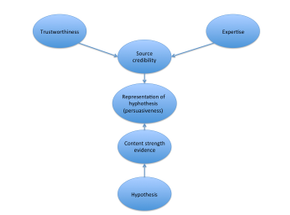Jens Koed Madsen
Post-docoral research
From January 2014, I received an individual research grant (DFF-1329-00021B) from the Danish Council for Independent Research (see LINK – link is in Danish). The research has three distinct targets, all concerned with the psychology of persuasion and the cognitive psychological model of persuasion processing developed in my PhD thesis, the Subjective-Probabilistic Interactive Model of Persuasion (SPIMP).
The aim is to extend the SPIMP model, to test it by examining obesity campaigns, and to integrate emotional appeals into the model.
The post-doctoral research project will be carried out in collaboration with Professor Mike Oaksford and his research group at Birkbeck (link), ranked in the top five Psychology departments in the UK. The research focus of this group is perfectly close to support my post-doctoral research. Birkbeck, University of London will provide me with all necessary resources to support my research, including access to equipment, laboratory facilities, and office accommodation.
If you have any questions or if you are interested in hearing more about the research, you are more than welcome to email me at overmuren [at] gmail.com

Extending the SPIMP: developing the model
One of the main contributions of my thesis is the development of a novel model of persuasion processing from a cognitive psychological perspective. The model describes how humans, in a persuasive context, approach and integrate uncertain information from an uncertain source. That is, over an amalgamation of subjectively estimated content strength and source credibility, the persuasiveness of the message for that particular individual emerges. This allows for discriminations such that the same information from the same source can be very different in terms of its persuasiveness for different people. For instance, a reference to the bible as grounds for a political proposal might be persuasive for Christians who believe in the bible whilst the same message from the same source (e.g. a politician) would be far less persuasive to an atheist who does not value the bible as a relevant source for political proposals. Thus, the model accounts for individual differences and predicts the persuasiveness of the message given subjective estimations of the strength of the content and the credibility of the source (expressed as expertise and trustworthiness).
Currently, however, the model remains rough. The elements of source credibility, expertise and trustworthiness, are currently equally weighted in the model. However, when considering these qualitatively, they are clearly not equal in terms of their relative weight on persuasive messages. This relative difference is not expressed in the model. Therefore, the post-doctoral research aims at further conceptual development of the SPIMP such that the model becomes more refined and distinguishes the relationship between elements in the model in a more precise and clear manner. Alongside theoretical development of the modelling, the research intends to explore behavioural data to distinguish between the influences of the elements of source credibility.
Analysis of obesity campaign: drawing in shadows
The model developed in the PhD thesis describes how humans approach uncertain information from uncertain sources in a potentially malevolent and deceptive situation. The description takes point of departure in the individual’s subjective estimations of content strength and source credibility. In this way, the model describes a central element in persuasion and influence, namely how humans manage uncertain beliefs.
The SPIMP approach to persuasion is concerned with changes in beliefs in situations where there is a persuasive intention. Thus, a person might change her beliefs without necessarily altering her behaviour (for example, changing her beliefs about a particular politician without changing her eventual vote). The link between belief and behaviour is of central importance to persuasion (change in beliefs) and influence (change in behaviour), as the link is neither straightforward nor necessary.
The post-doctoral research will analyse obesity campaigns in the UK and Denmark with focus on two main issues. Firstly, it will explore the analytic potential of the SPIMP vis-a-vis other descriptions of persuasion such as rhetorical analyses. As such, the analyses of obesity campaigns will test the model in a real world setting. Secondly and on a more fundamental level, the analyses of obesity campaigns are concerned with a critical reflection upon the limitations of persuasion and the SPIMP. If persuasion is defined as changes in beliefs that may or may not result in changes in behaviour, analyses of actual persuasive campaigns highlight the possible limitations of information-based and belief-based campaigns in terms of their effectiveness in changing behaviour. this second issue begs a meta-theoretical positioning of the model in which the SPIMP becomes lodged in a more complex and realistic relationship between the notions of persuasion and influence.
Aims and methods

Extending the SPIMP: developing the model
Aim: to refine and develop the SPIMP conceptually
Methods: computational modelling and experimental testing

Analysis of obesity campaign: drawing in shadows
Aims: describe the analytical potential and the conceptual limitations of the SPIMP and persuasion in general
Methods: Qualitative interviews, experimental testing, conceptual analyses

Integration of emotional appeals
Aim: Conceptually integrate emotion states in the SPIMP framework
Methods: literature review and experimental testing
Main aims: summary
- Provide further empirical testing of the model
- Describing the contributions and limitations of the model
- Placing the model in a larger theoretical framework
- Integrating emotional appeals
- Exploring analytic potential
- Conteptual development of the model
Integration of emotional appeals
Emotions are intuitively involved when humans process persuasive attempts. The current theoretical foundation for the SPIMP describes the psychology of reasoning regarding uncertain information from uncertain sources. Centrally, the evidence and sources are subjectively estimated. Recent developments in the psychology of emotion and reasoning show the involvement of emotion states when interpreting language, estimating the probabilistic content of evidence, and reasoning from evidence (such as conditional reasoning). Both intuitively and empirically, then, there is reason to assume the involvement of emotion states in persuasion processing. However, neither the SPIMP nor other prevalent cognitive psychological model of persuasion (such as the Elaboration Likelihood Model and the Heuristic-Systematic Model) account in detail for how emotions should be integrated in the models and theoretical frameworks.
The third element of the post-doctoral research explores how to integrate theories of emotion states within the SPIMP framework. This further qualifies the theoretical boundaries of the model and places it in a conceptually larger and more holistic context.
Project activities and publications
As the project has only recently been launched, the activities are still fairly minimal (mainly setting up collaborations). Therefore, there is little to report, but murmurs and inklings of activities. However, I will be updating this part of the website, as the project unfolds and progresses.
I am collaborating with a variety of people in order to explore the three aims of the project. The following is a non-exhaustive list of some of the central collaborators
UK institutions
Adam Harris (UCL)
David Lagnado (UCL)
Keith O’Brien (UCL)
Stanley Ulijaszek (University of Oxford)
Mike Oaksford (BBK)
Nick Chater (Warwick Business School)
Ulrike Hahn (BBK)
Anne Richards (BBK)
Ana Baeza Ruiz (University of Leeds/National Gallery)
Danish institutions
Thor Grünbaum (KU)
Stig hjarvard (KU)
Sune Vork Steffensen (SDU)
Sarah Bro Pedersen (SDU)
Stephen Cowley (SDU)
Torkild Sørensen (KU)
Klaus Grunert (AU)
Other people
Rebecca Chamberlain (UCL, Belgium)
Chris Street (University of Vancouver)
Hiroshi Yama (Osaka City University)
Giovanni Pezzulo (Rome)
Copyright © All Rights Reserved

